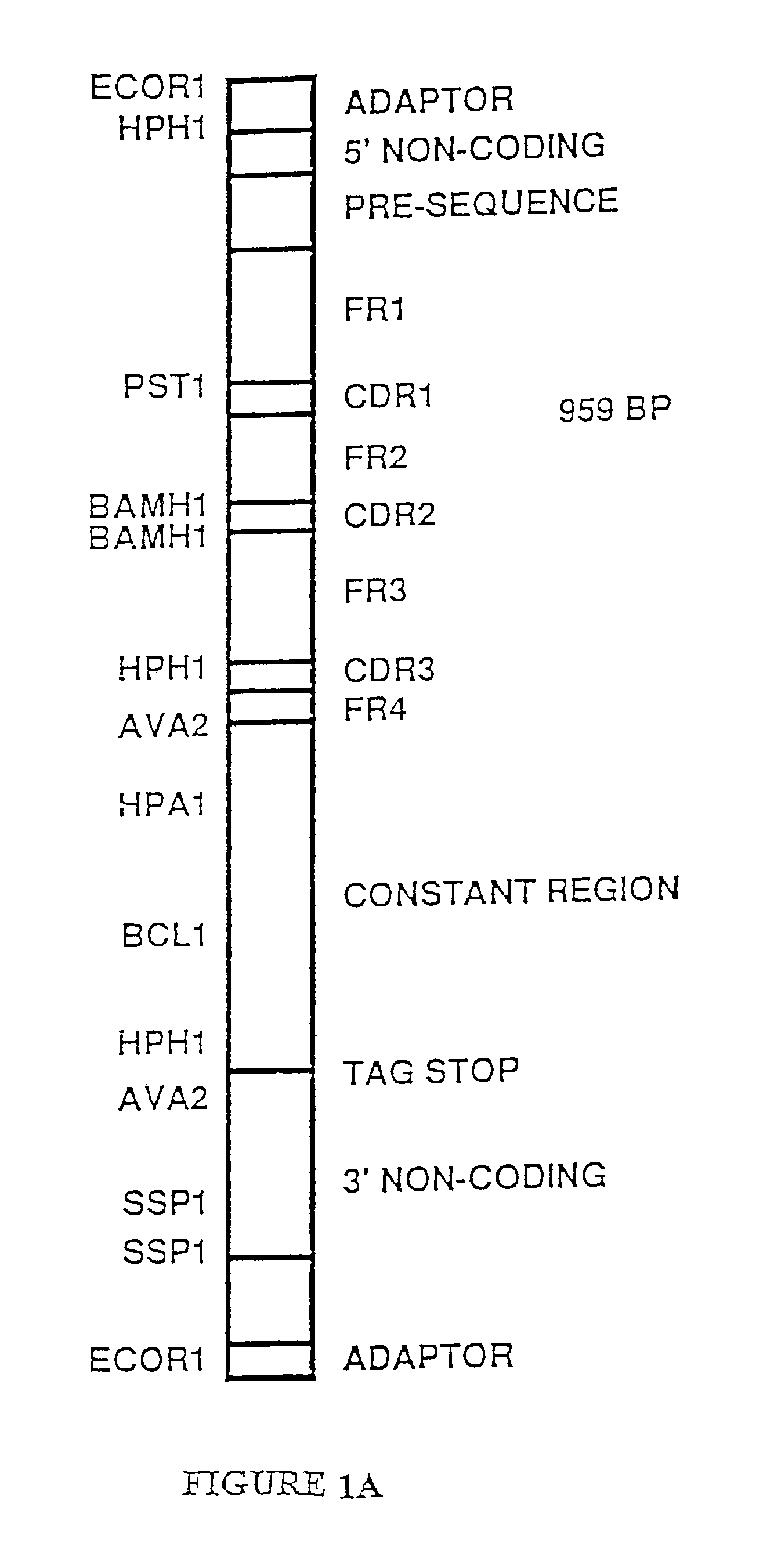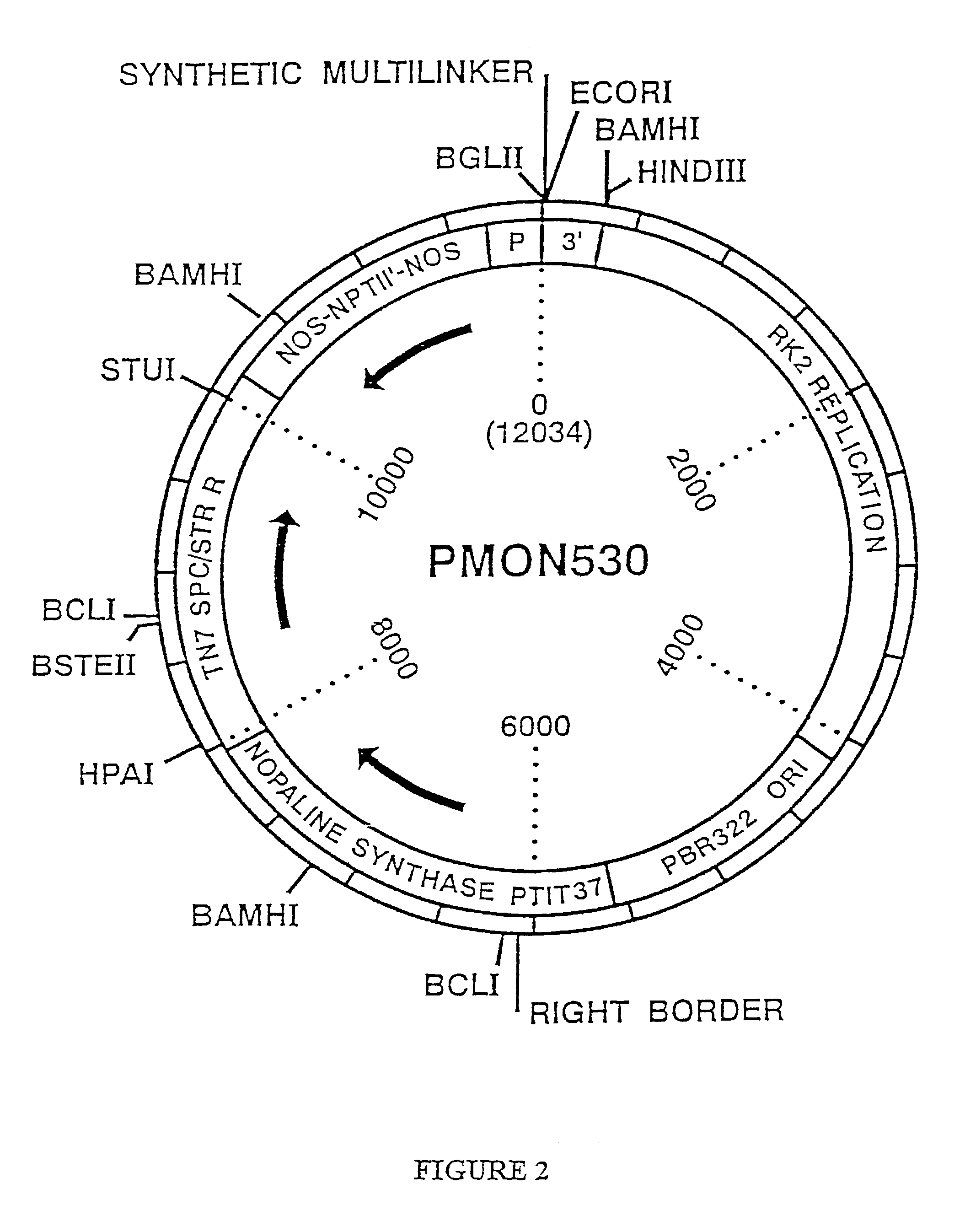Method of producing heteromultimeric mammalian proteins in plants
a technology of mammalian proteins and plants, applied in the field of foreign multimeric protein expression and assembly, can solve the problems of complex synthesis, inability to properly fold or process mammalian polypeptides derived from unicellular microorganisms to provide the desired degree, and inability to achieve the assembly and expression of useful amounts of secretory iga
- Summary
- Abstract
- Description
- Claims
- Application Information
AI Technical Summary
Benefits of technology
Problems solved by technology
Method used
Image
Examples
example 1
Isolation of an Immunoglobulin Heavy Chain-Coding Gene and an Immunoglobulin Light Chain-Coding Gene From The Hybridoma Cell Line 6D4
[0247]Hybridoma cells secreting the 6D4 antibody described by Tramontano et al., Science, 234: 1566–1570 (1986) were grown to log phase in DMEM medium supplemented with 10% fetal calf serum. Total RNA was prepared from 2 liters of log phase 6D4 hybridoma cells using the methods described by Ullrich et al., Science, 196:1313 (1977). Briefly, the 6D4 cells were collected by centrifugation and homogenized at room temperature for 20 seconds in 70 ml of 4 M guanidinium thiocyanate containing 5 mM sodium citrate at pH 7.0, 0.1 M 2-mercaptoethanol (2Me) and 0.5% sodium lauryl sarcosinate using a Polytron homogenizer. The homogenate was centrifuged briefly for 5 minutes at 8,000×g to remove the insoluble debris.
[0248]About 28 ml of homogenate was layered onto a 10 ml pad of 5.7 M CsCl (Bethesda Research Laboratories, Gaithersburg, Md.) in 4 mM ethylene diamine...
example 2
Construction of Expression Vectors Containing Kappa Light Chain Genes
[0273]An expression vector containing the entire kappa light chain gene including the kappa leader was produced in the following manner. The full length kappa light gene cDNA isolated above was mutagenized using polynucleotides P1 and P3 (Table 2) and the mutagenesis procedures described above. Polynucleotide P1 introduces an Eco RI restriction endonuclease site at the 5′ end of the full length kappa cDNA. Polynucleotide P3 introduces an Eco RI restriction endonuclease site at the 3′ end of the full length kappa light chain cDNA clone. Mutant transformants containing 2 additional Eco RI restriction endonuclease sites indicating that both polynucleotide PI and polynucleotide P3 had been introduced into the mutants were isolated. These mutants were then sequenced to confirm that they did contain the DNA sequence of both polynucleotide P1 and polynucleotide P3.
[0274]The full length kappa light chain cDNA (FIG. 1A) was...
example 3
Construction of Expression Vectors Containing Gamma Heavy Chain Gene
[0278]An expression vector containing the entire gamma heavy chain gene including the gamma leader was produced in the following manner. The full length gamma heavy chain gene cDNA isolated above was mutagenized using polynucleotides P4 and P6 (Table 2) and the mutagenesis procedures described above. Polynucleotide P4 introduces an Eco RI restriction endonuclease site at the 5′ end of the native full length gamma cDNA. Polynucleotide P6 introduces an Eco RI restriction endonuclease site at the 3′ end of the full length gamma heavy chain cDNA clone. Mutant transformants containing 2 additional Eco RI restriction endonuclease sites indicating that both polynucleotide P4 and polynucleotide P6 had been introduced into the mutants were isolated. These mutants were then sequenced to confirm that they did in fact contain the DNA sequence of both polynucleotide P4 and polynucleotide P6.
[0279]The full length gamma heavy chai...
PUM
| Property | Measurement | Unit |
|---|---|---|
| concentration | aaaaa | aaaaa |
| speeds | aaaaa | aaaaa |
| volume | aaaaa | aaaaa |
Abstract
Description
Claims
Application Information
 Login to View More
Login to View More - R&D
- Intellectual Property
- Life Sciences
- Materials
- Tech Scout
- Unparalleled Data Quality
- Higher Quality Content
- 60% Fewer Hallucinations
Browse by: Latest US Patents, China's latest patents, Technical Efficacy Thesaurus, Application Domain, Technology Topic, Popular Technical Reports.
© 2025 PatSnap. All rights reserved.Legal|Privacy policy|Modern Slavery Act Transparency Statement|Sitemap|About US| Contact US: help@patsnap.com



